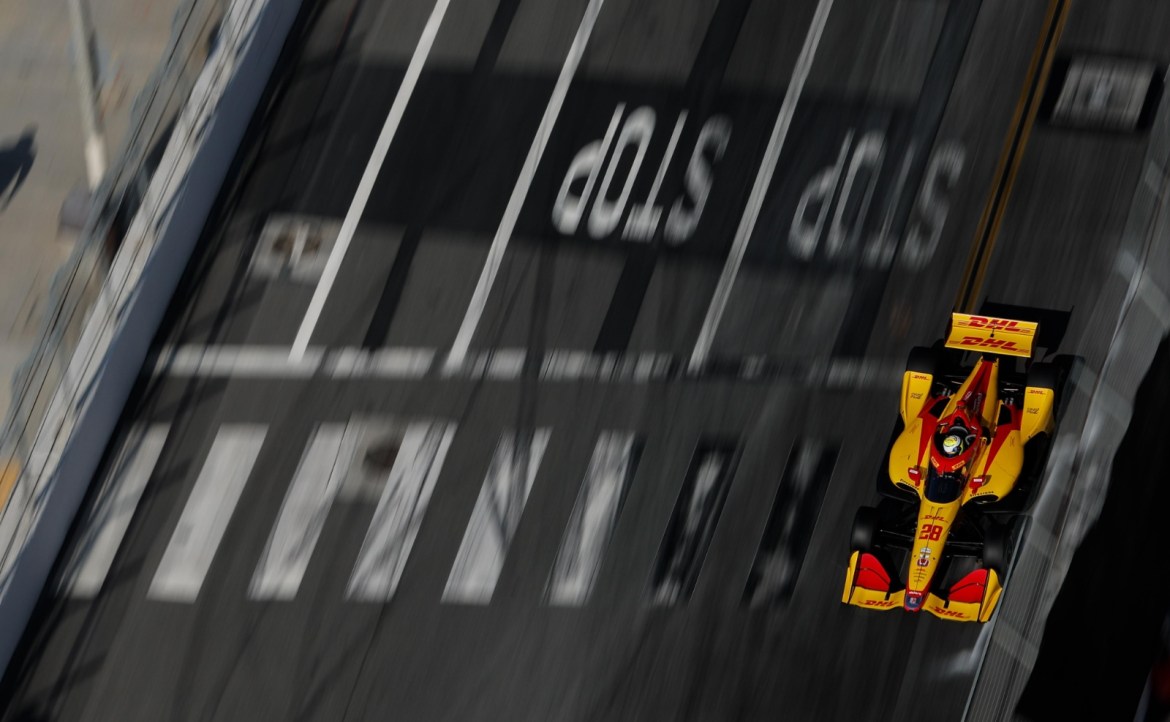Passing Data Reveals Positive Trends Through Season-Opening Races

Storylines abound just three races into the 2023 NTT IndyCar Series season.
One of the largest fields in recent memory has created drama on track and off with tempers flaring after two major pileups in St. Petersburg, pit lane contact for the current and former occupants of a particular pink-hued race car at Texas Motor Speedway, and brave passes in Long Beach’s Turn 5 leading to a “gloves off” response from a six-time series champion.
With all the action beaming into living rooms across the United States and beyond via NBC, Peacock, and other mediums, it’s tempting to get distracted by surface-level details: who won, who’s been the most consistent, and who hasn’t had the best start heading into Barber Motorsports Park, Indianapolis, and beyond.
The numbers behind the races aren’t always the most exciting aspect of motorsports, but it’s possible to distill one element of excitement into a single statistic: passing. In this regard, 2023 is off to a promising start.
Interpreting Passing Data With PI and PPI
INDYCAR has provided the total number of passes and position passes for each race since 2018. While these numbers are valuable and sometimes trumpeted by the series, mainly when a record is broken, raw passing totals don’t paint a complete picture.
Some races have longer distances than others due to average speed, track length, and the number of laps. For example, one would expect passing totals over longer distances to be higher; five years of data bear this out. Another factor to consider is the number of cars in the field, as more cars on track also increases the likelihood of passing. With an increasing car count since 2018, comparing passing totals over time is even more challenging if INDYCAR’s passing numbers are used in isolation.

Combining passes and position passes with “miles completed”, another statistic generously provided by the series, offers a method of analyzing passing while mitigating track and car count differences. It can also account for attrition, since a fully intact 33-car field in a 500-mile race would complete 16,500 miles, but the retirement of 10 cars at the halfway point would drop the miles run value to 14,000.
Miles completed for the Indianapolis 500 over the five years with available passing data ranges from 14,320 in 2020 to 15,770 in 2021. The importance of miles completed lies in the notion that a 33-car field that runs from start to finish will have more opportunities to pass throughout the race; as cars drop out and the miles completed total goes down, prospects for passing diminish accordingly.
Passing Index (PI) and Position Passing Index (PPI), the measures used by The Apex to compare passing across all races, represent the number of passes and position passes per 100 miles completed. For the available data set, the formula yields values between 0.71 and 17.67.
Even with the inclusion of miles completed, the measure cannot account for other factors that contribute to passing opportunities, such as restarts which allow the field to compress. Since ovals tend to have more passing opportunities than road and street courses, restarts disproportionately impact Texas, Indianapolis, Iowa, and Gateway.
Because of the inherent differences between ovals and non-ovals, grouping races by track type yields greater insight, while comparing the same race over time returns the most helpful analysis. Each of the first three races of the 2023 season saw an uptick in Passing Index and Position Passing Index over the previous year, yet the trends for each race are unique.
Streets of St. Petersburg — 4.87 PI, 3.67 PPI

This year’s edition of the Firestone Grand Prix of St. Petersburg, notable for five-full course cautions causing 26% of its distance to run under yellow, did not match the high watermark of 2018, which had a PI of 8.30.
Compared to subsequent years, 2018 appears to be an anomaly attributable to several causes, including being the first year and race to feature the now-ubiquitous universal aero kit. From 2019 to 2022, passing in St. Petersburg remained relatively consistent, with a PI ranging from 2.98 in 2019 to 4.06 in 2022.
As evidenced by the chart above, the Passing Index and Position Passing Index increased this year. The number of restarts may have played a role, but the cautions that led to the restarts also caused significant attrition by reducing both car count and passing opportunities. Weak correlation between the number of cautions and passing in St. Petersburg is also evident when comparing 2023’s five cautions to six in 2020.
Texas Motor Speedway — 13.73 PI, 5.20 PPI

As the only oval of the first three events, Texas Motor Speedway’s passing chart features the most dramatic swing over the previous year.
The track’s recent history of surface changes and INDYCAR’s attempts in the last two years to improve racing by having dedicated practice sessions to rubber in the high line are borne out in the data, which show a steep dip in PI and PPI culminating in 2021.
Passing began to rebound in 2022 and soared this year. The 13.73 PI registered in 2023 represents the fourth-highest Passing Index since data became available five seasons ago, and the mark is bested only by three events held at Iowa Speedway. From a position passing standpoint, the 2023 PPG 375 ranks sixth behind events at Iowa, St. Petersburg, and the Indianapolis Motor Speedway road course.
Casual observers and racing pundits may have felt that the race was more active than in previous years, and they’re right: even with a larger field of 28 cars, the on-track action, measured by Passing Index, sets a new bar for the 1.5-mile oval.
Streets of Long Beach — 5.94 PI, 3.33 PPI

IndyCar’s most recent event, the 2023 Acura Grand Prix of Long Beach, shares elements of both St. Petersburg and Texas. Like the season opener, this year’s visit to Southern California represented an improvement in both passing and position passing over 2022; like Texas, the race had the highest Passing Index since 2018, although the Position Passing Index did not match that year’s 3.59.
If St. Pete’s anomalously high Passing Index in 2018 is ignored, the similar trend for both street course races is striking, with dips in 2019 and 2022 and bumps in 2018, 2021, and 2023.
Unfortunately, Long Beach’s cancellation in pandemic-affected 2020 prevents a true year-over-year comparison. Still, the data suggest a commonality between the two street circuits that may be influenced by any number of factors, from officiating changes to varied Firestone tire compounds.

With 14 races remaining, the 2023 IndyCar season has only just begun, but the first three events show a promising trend, both when compared to previous years and compared to each other, despite being held in different parts of the country with unique track conditions and two disparate track types.
More street circuits and ovals in 2023 will offer further data to surface any emerging trends, and the upcoming venues — starting with two road courses — will provide additional data points as the season rolls on.
For readers interested in following the data as it becomes available, each of the Race Reports published this year have historical passing figures on the History tab and Passing Index details for the just-completed race on the Post-Race tab.
Ben was hooked after witnessing Dario Franchitti's victory at the 2009 Iowa Corn Indy 250 and began providing media coverage from IndyCar events in 2015. If IndyCar is on track, he can be found live-posting and updating The Apex's Race Reports from his iPad Pro.
